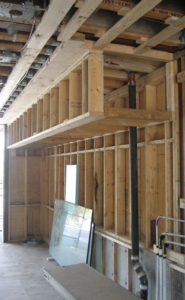Housing is any structure or portion of a structure that provides room for people to live. This includes houses, apartments, and other buildings that people can rent or own.
A housing unit is a separate living quarter in a house, apartment, or other structure where people eat, sleep, and live. It can also be a group of rooms in a hotel or motel. Click the https://www.teamhousing.com/ to learn more.

Housing is a basic need and plays a critical role in establishing communities, supporting social interactions, and contributing to individuals’ well-being and quality of life. It includes a range of dwellings, from homes to apartments and condos, that provide individuals with a permanent place of residence, which is often referred to as a street address. Housing can be rented or owned and is typically designed to provide residents with privacy, safety, and security.
The type of housing built, and its availability, can have a significant impact on the overall character of an area. Providing affordable housing is a key way for cities to add value to their neighborhoods by improving local economic conditions. It increases the number of people who can afford to live within a reasonable commute and makes it easier for local businesses to attract employees.
Investing in affordable housing also brings social benefits, including the fact that children who have a stable place to live are more likely to graduate from high school and less likely to fall into homelessness or other forms of poverty. Local governments, such as city councils, often develop housing policies and initiatives to ensure that all citizens have access to affordable living.
The availability of affordable housing also provides a level of resilience during recessions, as it is typically not affected by the same drop in demand that affects luxury properties. However, the scarcity of affordable housing in many urban areas results in lengthy waiting lists that remain filled with prospective applicants.
It increases property values.
Housing refers to the structures that people live in, and it can be rented or owned. It’s an important part of a community, and it contributes to people’s well-being and quality of life. It serves several purposes, including providing privacy and safety, establishing communities, and supporting social interactions. It can also be used as an investment. There are a number of factors that influence property values, such as location, economic conditions, home improvements, and market trends. By understanding these factors, homeowners can increase their property values.
A major factor that influences property values is the availability of affordable housing. When there is limited housing supply, it can push up prices, as buyers compete to buy available properties. Additionally, higher costs can lead to less disposable income for families, which may limit their spending on other items such as food, health care, and education.
There are a number of ways to increase affordable housing, such as improving the supply of new construction, increasing incentives for developers to build more affordable units, and encouraging local governments to change outdated zoning rules. In addition, the Biden Administration has taken a variety of steps to support affordable housing, including strengthening the Low-Income Housing Tax Credit, expanding federal investments in affordable housing, supporting community development financial institutions and minority depository institutions, and permanently extending a key HUD risk-sharing initiative.
Another important factor that influences property value is the quality of a neighborhood. Homes located in desirable school districts have a higher resale value than those in less-popular neighborhoods. Additionally, the proximity to employment centers can affect a home’s value.
It increases pride in the neighborhood.
When people live in homes that look well-maintained, feel safe and secure, have access to transportation, jobs and schools, and see neighbors taking advantage of amenities like parks and bike shares, they’re more likely to be proud of their neighborhood. This can be true whether the homes are owned by a single person or family, or are part of a large apartment complex or other multi-unit development.
Better-designed housing may also be more attractive and interesting, drawing in new residents who would not have considered the area before. Oftentimes, this means more foot traffic on the streets, which can help increase safety and create a sense of community.
A strong sense of pride in the neighborhood can lead to improved maintenance by those living in it, including more lawn mowing and cleaning, and even the addition of decorative features like flowerbeds or window boxes. This is especially true when the improved housing is built in a way that makes it seem like a natural fit in the surrounding neighborhood, rather than an imposing addition that looks out of place.
The Gallup-Sharecare Well-Being Index reports that neighborhoods where people are more proud of their communities tend to have better public services, including police and fire departments, as well as lower violence and vandalism rates. In addition, they’re more likely to be willing to pay taxes for these public services, which helps the city fund them and provide a safer environment.
If you want to improve your neighborhood, start by conducting a needs and assets assessment of the area. Then, focus on bringing in higher-quality housing, particularly that that is affordable for low- and moderate-income residents. Then, work to promote it as much as you can – write letters to the editor or contact your local media outlets, show officials examples of affordable housing and recruit other influential people in your network to support your cause.
It increases the potential or actual workforce in the area.
Housing is a basic human need, providing shelter and accommodation for families. It also contributes to a sense of well-being and social interaction. It can be rented or owned and can include amenities to support daily activities. There are different types of housing, including traditional homes, apartments, and condos. The best housing provides safe, comfortable, and affordable accommodations that meet the needs of individuals and families.
Workforce housing is essential to a community’s economic competitiveness. Many companies are reluctant to relocate workers if there is not adequate workforce housing available nearby. This can result in increased turnover rates, affecting job stability and the long-term growth of a company.
Various factors can influence the demand for workforce housing, such as economic conditions, population growth, migration patterns, and market sentiment. In addition, commuting costs and lifestyle preferences can affect the type of housing demanded. For example, younger generations tend to prefer single-person households with outdoor amenities, while older populations are more interested in accessible and age-restricted housing.
The development of workforce housing can be a challenge, especially in areas with high real estate prices. However, there are several ways to reduce the cost of workforce housing, including through public-private partnerships and local government funding. In addition, building homes with flexible designs and implementing sustainable building practices can lower long-term operating costs.
The term “affordable housing” is generally defined as a home that does not exceed 30% of an individual’s income. It is important to understand that not all housing is affordable, and some low-income individuals and families spend more than 50% of their income on housing. This can lead to stress, health problems, and lack of education for children.
It preserves or creates open space.
The preservation of open space is important because it adds to the beauty and appeal of neighborhoods and creates a sense of community. It also benefits the environment by combating air pollution, reducing noise levels, controlling wind, providing erosion control and moderating temperatures. It can also serve to protect surface and ground water resources by filtering trash, debris and chemical pollutants before they enter the water supply.
In addition, affordable housing can benefit local economies by fostering economic growth and creating jobs during construction and maintenance. Stable housing can also result in better educational outcomes for children and reduce stress and anxiety. Finally, affordable housing can reduce crime rates by promoting social stability in communities.
Subsidized housing refers to any federal, state or local government program designed to reduce the cost of housing for low- and moderate-income families and individuals. This may include renting to people with vouchers, assisting homebuyers with down payment assistance or reduction of interest rates on mortgages, providing tax credits and more.
Scattered-site housing units are a form of public housing that is dispersed throughout the community rather than being concentrated in one or more specific neighborhoods. They were developed as an alternative to traditional high-density housing to avoid the concentration of poverty that is often associated with public housing in urban areas and to prevent racial segregation. However, these types of homes can be difficult to maintain and have been linked to a variety of problems, including crime and poor education. Scattered-site housing is also associated with high turnover and is generally more expensive to operate than other forms of public housing.








